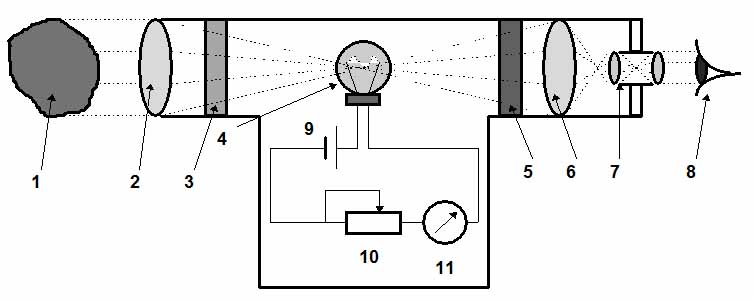Optical pyrometers, sometimes referred to as brightness thermometers, generally involve wavelengths only in the visible part of the spectrum. When the temperature of the body increases, so does the intensity at any particular wavelength. If two bodies have the same temperature, then intensities of those two objects are equal. In this type of a pyrometer the intensity of a certain wavelength of a heated body is compared with that of a heated platinum filament of a lamp (see Fig. ).
An object 1 which temperature is to be measured, emits electromagnetic radiation with intensity proportional to its absolute temperature. This radiation passes through lens 2 and red optical filter 3. Optical filter picks out only the desired wavelength - red. Then radiation focuses on the platinum filament of a lamp 4, and passes through another filter 5, lens 6, viewing system 7. The viewer 8 sees the platinum filament superimposed on an image of the object 1. When the temperature of the filament is low comparing with that of the object, the viewer sees the filament as a dark line on the bright background image of the object. The lamp 4 is connected in series with an electrical battery 9, a variable resistor 10 and an ampermeter 11.
By reducing the resistance of the resistor an electrical current passing through the filament increases. So does the temperature of the filament and its brightness. For a certain value of an electrical current (corresponded to a certain value of an object temperature), the brightness of the platinum filament will match the brightness of the object 1. At this setting the viewer cannot distinguish between the image of the object and the filament. At this time the measurement of temperature is performed. The scale of the ampermeter is calibrated in the units of temperature.
The lower temperature limit for optical pyrometers is determined by the temperature at which objects become visible in red (about 225 °C). However, there are devices which are able to measure even lower temperatures down to -50 °C. The upper limit varies from 600 to 3000 °C, and is limited by the melting point of the platinum filament. An accuracy is typically varied from ±5 to ±10 K.
